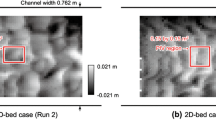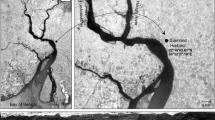Abstract
The presence of an upstream ramp in a triangular (hump) weir (TW-UR) increases its discharging capacity and sediment passage possibilities than traditional weirs. Presented in this paper is an experimental investigation on the tracking of incipient movement of individual sediment particle sizing from 1.4 to 3.07 mm over the channel bed upstream of a TW-UR and its ramp. The sediment movements were recorded by a high-speed camera and analysed using image processing techniques. The shear stress on smooth upstream bed was calculated using Acoustic Doppler Velocimeter. The critical condition for sediment movement over upstream bed and its regime were compared with previous investigations. Furthermore, Computational Fluid Dynamics simulation was performed to compute the shear stress on the upstream ramp. It was found that sediment loses its velocity while approaching the ramp and stops momentarily at the toe of the ramp. The maximum particle velocity at the end of the ramp varies from 0.47 to 0.78 m s−1. Enhanced hydrodynamic force along the ramp increases the particle kinematics. A rapid increase in shear stress was observed in the downstream part of the ramp. The ratio of maximum particle velocity to flow velocity near the ramp end is around 0.75. It was found that about 20–60% of additional shear stress is required to move particles over the ramp. The present study is useful for maintaining the sediment continuity in channels using triangular (hump) weirs which are basically used as embankment weirs.
Graphical abstract









Similar content being viewed by others
Abbreviations
- a s :
-
Resultant acceleration of sediment particle (m s−2)
- d :
-
Size of sediment particle (× 10−3 m)
- D 1 :
-
Distance from the right wall of the flume (m)
- F:
-
Froude number of the approach flow (-)
- F s :
-
Resultant force on sediment particle (× 10−5 N)
- F t :
-
Total hydrodynamic force acting on the particle due to the combination of drag and lift (× 10–5 N)
- h :
-
Brink depth of water over the weir edge (m)
- L r :
-
Horizontal distance from the beginning of TW-UR (m)
- L r1 :
-
Captured length (m)
- L r2 :
-
Actual length (m)
- N sh :
-
Shields number (–)
- Q :
-
Discharge (× 10−3m3 s−1)
- Re* :
-
Particle Reynolds number (–)
- Rp :
-
Explicit particle Reynolds number (–)
- S s :
-
Specific gravity of sediment (–)
- u c * :
-
Critical shear velocity (m s−1)
- u c :
-
Characteristics velocity (m s−1)
- V c :
-
Mean flow velocity at 1.0 m upstream of the weir (m s−1)
- v s :
-
Resultant velocity of sediment particle (m s−1)
- v s max :
-
Maximum resultant velocity of sediment particle (m s−1)
- V max :
-
Maximum flow velocity near the downstream weir drop (m s−1)
- W′ :
-
Submerged weight of the particle (N)
- y :
-
Depth of flow (m)
- α :
-
Inclination angle or upstream angle of weir to the horizontal axis (degree)
- γ :
-
Specific weight of water (N m−3)
- ν :
-
Kinematic viscosity (m2 s−1)
- θ s :
-
Angle of orientation of sediment particle velocity to the horizontal axis (degree)
- τ o :
-
Bed shear stress at any location over the upstream ramp (N m−2)
- τ bcib :
-
Critical bed shear stress corresponding to the incipient movement of sediment over upstream bed (N m−2)
- τ bcir :
-
Critical bed shear stress corresponding to the incipient movement of sediment over TW-UR (N m−2)
References
Abbott JE, Francis JRD (1977) Saltation and suspension trajectories of solid grains in a water stream. Philos Trans R Soc Math Phys Eng Sci 284(1321):225–254
Abou-Seida MM, Quraishi AA (1976) A flow equation for submerged rectangular weirs. Proc Inst Civ Eng Part 2 61(4):685–696
Ancey C, Bigillon F, Frey P, Lanier J, Ducret R (2002) Saltating motion of a bead in a rapid water stream. Phys Rev E 66(036306):1–16
ANSYS (2018) ANSYS academic research mechanical and CFD, Release 19.1. Canonsburg
Azimi AH, Rajaratnam N, Zhu DZ (2012) A note on sharp-crested weirs and weirs of finite crest length. Can J Civ Eng 39(11):1234–1237
Azimi AH, Rajaratnam N, Zhu DZ (2013) Discharge characteristics of weirs of finite crest length with upstream and downstream ramps. J Irrig Drain Eng 139(1):75–83
Bai Y, Duan JG (2014) Simulating unsteady flow and sediment transport in vegetated channel network. J Hydrol 515:90–102
Bates PD, Lane SN, Ferguson RI (2005) Computational fluid dynamics: applications in environmental hydraulics. John Wiley & Sons Ltd, Chichester
Bhattacharyya A, Ojha SP, Mazumder BS (2013) Evaluation of the saltation process of bed materials by video imaging under altered bed roughness. Earth Surf Process Landforms 38(12):1339–1353
Bombardelli FA, González AE, Niño YI (2008) Computation of the particle basset force with a fractional-derivative approach. J Hydraul Eng 134(10):1513–1520
Bridge JS, Dominic DF (1984) Bed load grain velocities and sediment transport rates. Water Resour Res 20(4):476–490
Carvalho E, Maia R, Proença MF (2010) Shear stress measurements over smooth and rough channel beds. In: Proceeding of the River Flow 2010 Conference, Braunschweig, Germany, pp 367–375
Chien N, Wan Z (1999) Mechanics of sediment transport. American Society of Civil Engineers, Reston
Chiew Y, Parker G (1994) Incipient sediment motion on non-horizontal slopes. J Hydraul Res 32(5):649–660
Fan J, Morris GL (1992) Reservoir sedimentation. I: Delta and density current deposits. J Hydraul Eng 118(3):354–369
Ferro V (2003) ADV measurements of velocity distributions in a gravel-bed flume. Earth Surf Process Landforms 28:707–722
Fritzi BHM, Hager WH (1998) Hydraulics of embankment weirs. J Hydraul Eng 124(9):963–971
Garde RJ, Albertson ML (1959) Sand waves and regimes of flow in alluvial channels. In: IAHR, 8th Congress (Vol. 4), Montreal
Garde RJ, Ranga Raju KG (2015) Mechanics of sediment transportation and alluvial stream problems. Revised third edition. New Age International (P) Ltd., New Delhi
Gebhardt M, Herbst J, Merkel J, Belzner F (2019) Sedimentation at labyrinth weirs—an experimental study of the self-cleaning process. J Hydraul Res 57(4):579–590
Horton RE (1907) Weir experiments, coefficients, and formulas. U.S. Geological survey water-supply and irrigation paper No. 200, Series M, General Hydrographic Investigations, 24, Government Printing office, Washington, DC
Kadia S (2019) Movement of sediment over a piano key weir. M. Tech. Dissertation, Indian Institute of Technology Roorkee
Kadia S, Kumar B, Ahmad Z (2019) Piano key weir as a dam safety technique and its CFD modelling in ansys CFX module. In: Compendium of technical papers for the international dam safety conference—2019, Bhubaneswar, India, Central Water Commission, New Delhi, pp 91–99
Kadia S, Kumar B, Ahmad Z (2020) Discharge characteristics of triangular weir with upstream ramp and its CFD modelling using ansys CFX module. In: Kalinowska MB, Mrokowska MM, Rowiński PM (eds) Recent trends in environmental hydraulics. Geoplanet: earth and planetary sciences. Springer, Cham, pp 77–90
von Kármán T (1930) Mechanische Ahnlichkeit und Turbulenz. Nachrichten von der Gesellschaft der Wissenschaften zu Göttingen: Mathematisch-physische Klasse, pp 58–79 [in German]
Kirkgöz MS, Ardiçlioğlu M (1997) Velocity profiles of developing and developed open channel flow. J Hydraul Eng 123(12):1099–1105
Kumar B, Kadia S, Ahmad Z (2019) Experimental study of flow field and movement of sediment over a ramp. J Civ Eng Construct 8(2):79–86
Kumar B, Kadia S, Ahmad Z (2021) Study on sediment movement over type-A piano key weirs. J Irrig Drain Eng 147(6):04021018
Launder BE, Spalding DB (1972) Lectures in mathematical models of turbulence. Academic Press, London
Launder BE, Spalding DB (1974) The numerical computation of turbulent flows. Comput Methods Appl Mech Eng 3:269–289
Lee H, Hsu I (1994) Investigation of saltating particle motions. J Hydraul Eng 120(7):831–845
Mazumder BS, Bhattacharyya A, Ojha SP (2008) Near-bed particle motion due to turbulent flow using image-processing technique. J Flow vis Image Process 15(1):1–15
Moreno-Casas PA, Bombardelli FA (2016) Computation of the Basset force: recent advances and environmental flow applications. Environ Fluid Mech 16(1):193–208
Niño Y, García M (1998a) Using Lagrangian particle saltation observations for bedload sediment transport modelling. Hydrol Process 12(8):1197–1218
Niño Y, García M (1998b) Experiments on saltation of sand in water. J Hydraul Eng 124(10):1014–1025
Noseda M, Stojnic I, Pfister M, Schleiss AJ (2019) Upstream erosion and sediment passage at piano key weirs. J Hydraul Eng 145(8):04019029
Novak P, Nalluri C (1975) Sediment transport in smooth fixed bed channels. J Hydraul Div 101(9):1139–1154
Novak P, Nalluri C (1984) Incipient motion of sediment particles over fixed beds. J Hydraul Res 22(3):181–187
Prandtl L (1932) Zur turbulenten Strömung in Röhren und längs Platten. Ergebn Aerodyn Versuchsanstalt Göttingen 4:18–29 ([in German])
Ramesh B, Kothyari UC, Murugesan K (2011) Near-bed particle motion over transitionally-rough bed. J Hydraul Res 49(6):757–765
Safari MJS, Aksoy H, Unal NE, Mohammadi M (2017) Experimental analysis of sediment incipient motion in rigid boundary open channels. Environ Fluid Mech 17(6):1281–1298
Shaker AJ, Sarhan AS (2017) Performance of flow over a weir with sloped upstream face. ZANCO J Pure Appl Sci 29(3):43–54
Sharma N, Tiwari H (2013) Experimental study on vertical velocity and submergence depth near piano key weir. In: Proceedings of the Second International Workshop on Labyrinth and Piano Key Weirs—PKW 2013, Paris, France, CRC Press, London, pp 93–100
Shields IA (1936) Anwendung der Aehnlichkeitsmechanik und der Turbulenzforschung auf die Geschiebebewegung. Mitteilungen der Pruessischen Versuchsanstalt für Wasserbau und Schiffbau, Berlin ([in German])
Shim J, Duan JG (2017) Experimental study of bed-load transport using particle motion tracking. Int J Sediment Res 32(1):73–81
Shim J, Duan J (2019) Experimental and theoretical study of bed load particle velocity. J Hydraul Res 57(1):62–74
Tiwari H, Sharma N (2015) Flow hydrodynamics near inlet key of Piano Key Weir (PKW). Sadhana 40(7):2253–2261
Tregnaghi M, Bottacin-Busolin A, Tait S, Marion A (2012) Stochastic determination of entrainment risk in uniformly sized sediment beds at low transport stages: 2. Experiments. J Geophys Res Earth Surf 117(F4005):1–17
Voulgaris G, Trowbridge JH (1998) Evaluation of the acoustic Doppler velocimeter (ADV) for turbulence measurements. J Atmos Oceanic Tech 15(1):272–289
Wiberg PL, Smith JD (1985) A theoretical model for saltating grains in water. J Geophys Res 90(C4):7341–7354
Acknowledgements
The first author is grateful to the Ministry of Human Resources Development, Govt. of India for research scholarship.
Funding
Not applicable.
Author information
Authors and Affiliations
Corresponding author
Ethics declarations
Conflict of interest
Authors hereby declare that they do not have conflict of interests.
Code availability
Not applicable.
Availability of data and material
Data and material can be obtained from the corresponding author.
Additional information
Publisher's Note
Springer Nature remains neutral with regard to jurisdictional claims in published maps and institutional affiliations.
Rights and permissions
About this article
Cite this article
Kumar, B., Kadia, S. & Ahmad, Z. Sediment movement over a triangular weir with an upstream ramp using a high-speed camera. J Vis 25, 1017–1033 (2022). https://doi.org/10.1007/s12650-022-00831-0
Received:
Revised:
Accepted:
Published:
Issue Date:
DOI: https://doi.org/10.1007/s12650-022-00831-0




